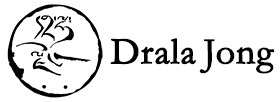Ngak’chang Rinpoche (pictured above with Khandro Déchen his wife and two children Robert and Raechel) is a Lama of the Nyingma Tradition within Vajrayana Buddhism. Born in 1952 in Hannover Germany—of an English father and German mother—he is the great grand-nephew of Franz Schubert. He was raised in England—attended Farnham Art School—and later Bristol Art School, where he gained a first class honours degree in Illustration (Fine Art painting and print making). Subsequent to receiving his BA degree in 1975 he spent the next eleven years travelling and studying in India and Nepal, where he studied thangka painting, and calligraphy – as part of the Lama’s training (study, practise, and retreat) he commenced with Kyabjé Düd’jom Rinpoche in 1971 during a sabbatical year from Art School.
Written words are sacred in Tibet, because the carry the knowledge of liberation. The scripts Rinpoche uses are called u-chen and u’mèd – and they originate in part from the ancient script: Lha-bab yig-gé, meaning: script-symbols from the sky-expanse. The calligraphic form of these ‘sky signatures’ are thus both ancient and contemporary. Their spontaneous style was first evolved by Chögyam Trungpa Rinpoche from the influence of his friendship with the Zen Master, Shunryu Suzuki Roshi. Variants of this style were later taken up by Ta’i Situ Rinpoche and other Lamas.
Spontaneous calligraphy is new to the Tibetan tradition – and as yet has no established form. Each Lama works individually. Rinpoche uses a variety of turnip-shaped Japanese brush which holds a considerable quantity of shellac based Indian Ink. The line produced by these brushes can vary from a hair’s breadth to two inches in width, according to the pressure exerted – and Rinpoche often uses the full range of possible widths within a single calligraphy – the result being a startling dance of chaos and precision. Rinpoche simmers Indian ink over a gentle flame to reduce its water content – thereby increasing the density of the ink. This gives an unusual crispness and shine to the calligraphies – reminiscent of thermographic images, in which resin is employed to produce a raised surface in the printing process.
Rinpoche uses a ‘heavily loaded brush’ rather than the ‘dry brush’ of the Chinese and Japanese styles. Due to the speed at which the calligraphies are executed, erratic ink droplets explode onto the paper. This causes the ‘splatters’ by which Rinpoche’s calligraphies have become known. The splatters—due to that viscosity of the ink—settle in dramatic patterns on most of his calligraphies.
Rinpoche uses two types of paper – hand-made rag paper from Sikkim and Tibetan birch-bark paper.
The hand-made rag paper has various unusual qualities. Being inconsistently absorbent / non-absorbent it is unpredictable in use. The paper Rinpoche employs is pressed between thread-bare blankets and therefore not always available – as blankets are now more frequently replaced. He sometimes has to wait a few years before new supplies of the ‘inferior quality paper’ becomes available – and then has to take whatever is available. The process of pressing between thread bare blankets gives each sheet a unique texture – the roughness of the warp and weft break the edge of brush strokes allowing tremendous variation in character of each sky signature. Sometimes smooth spots occur where holes occur in the blankets and where these are found, Rinpoche employs them as part of the calligraphy.
Tibetan birch-bark type is rougher, has visual characteristics, and is absorbent. A more sparsely loaded is therefore employed. The paper from Sikkim results in more starkly dynamic appearance and the Tibetan paper results is more wistful æthereal appearance.
Ngak’chang Rinpoche is also skilled at a range of other art forms, including poetry, musical performance and creation (most especially the electric bass, electric and acoustic guitar, blues harp and blues vocals, along with being a lyricist), gar cham (vajrayana Buddhist dance) and traditional thangka painting, which he also teaches.



Leave A Comment